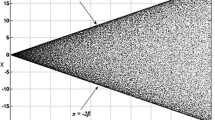Abstract
Increasing information transmission in public networks raises a significant number of questions. For example, the security, the confidentiality, the integrity and the authenticity of the data during its transmission are very problematical. So, encryption of the transmitted data is one of the most promising solutions. In our work, we focus on the security of image data, which are considered as specific data because of their big size and their information which are of two-dimensional nature and also redundant. These data characteristics make the developed algorithms in the literature unavailable in their classical forms, because of the speed and the possible risk of information loss. In this paper, we develop an original “images encryption” algorithm based on evolutionary algorithms. The appropriateness of the proposed scheme is demonstrated by the sensitivity to images, the key and the resistibility to various advanced attacks.













Similar content being viewed by others
References
Souici, I. Seridi, H., & Aissaoui, Z. (2007). Nouvel algorithme de chiffrement évolutionnaire ACEO. JIG’07. 3èmes Journées internationales sur l’Informatique Graphique. Constantine. Algérie.
Souici, I., Aissaoui, Z., & Seridi, H. (2008). Conception et Evaluation d’un Nouvel Algorithme Crypto-évolutionnaire (SSA). COSI’08. Colloque sur l’Optimisation et les Systèmes d’Information. Tizi-Ouzou. Algérie.
Katzenbeisser, S., & Petitcolas, F. A. P. (2000). Information hiding techniques for steganography and digital watermarking. London: Artech House.
Kahn, D. (1996). The Codebreakers—The story of secret writing. New York: Scribner.
Kobayashi, M. (1990). Digital watermarking: Historical roots. Technical report, IBM Research, Tokyo Research Laboratory. Japan.
Darwin, C. (1859). On the origin of species by means of natural selection, or the preservation of favoured races in the struggle for life. London: John Murray.
Fogel, L., Owens, A., & Walsh, M. (1966). Artificial intelligence through simulated evolution. Chichester, UK: Wiley. In (Jour, 2003).
Rechenberg, I. (1973). Evolutions Strategie: Optimierung technischer Systeme nach Prinzipien der biologischen Evolution. Stuttgart: Frommann-Holzboog. In [Jour, 2003].
Holland, J. (1975). Adaptation in natural and artificial systems. Ann Arbor: University of Michigan Press.
Koza, J. (1992). Genetic programming. Cambridge, MA: MIT Press.
Prabhu, D., Buckles, B. P., & Petry, F. E. (2000). Genetic algorithms for scene interpretation from prototypical semantic description. International Journal of Intelligent Systems, 15(10), 901–918.
Grenfenslette, J. J. (1986). Optimization of control parameters for genetic algorithms. IEEE Transaction on Systems, Man, and Cybernetics, 16(1), 122–128.
Davis, L. (1989). Adapting operator probabilities in genetic algorithms. In Proceedings of the third international conference on genetic algorithms (ICGA’89), George Mason University, Fairfax, Virginia, USA, June 1989 (pp. 61–69).
Bäck, T. (1997). Mutation parameters. Handbook of evolutionary computation. 97/1, E1.2, IOP Publishing Ltd.
Hutter, F., Hamadi, Y., Hoos, H. H., & Leyton-Brown, K. (2006). Performance prediction and automated tuning of randomized and parametric algorithms. In CP 2006, number 4204 in LNCS (pp. 213–228). Springer Verlag.
Eiben, A. E., Michalewicz, Z., Schoenauer, M., & Smith, J. E. (2007). Parameter control in evolutionary algorithms. In F. G. Lobo, C. F. Lima, & Z. Michalewicz (Eds.), Parameter setting in evolutionary algorithms, studies in computational intelligence (pp. 19–46). Springer.
Bibai, J., Savéant, P., Schoenauer, M., & Vidal, V. (2010). On the generality of parameter tuning in evolutionary planning. In ACM Genetic and Evolutionary Computation Conference (GECCO-2010) (pp. 241–248). Portland, Oregon: United States.
Djeddi, M., Ouahabi, A., Batatia, H., Basarab, A., & Kouamé, D. (2010). Discrete wavelet for multifractal texture classification: Application to medical ultrasound imaging. In IEEE international conference on image processing, Hong Kong.
Ouahabi, A. & Ait Aouit, D. (2008). Wavelets and fractals for signal and image analysis. In P. Siarry (Ed.), Optimization in signal and image processing (pp. 45–77). London: ISTE; Hoboken: Wiley.
Kerckhoffs, A. (1983). La cryptographie militaire. Journal des sciences militaires, IX, 5–38.
Shannon, C. (1949). Communication theory of secrecy systems. Bell Systems Technical Journal, 28, 656–715.
Stinson, D. (1996). Cryptographie, théorie et pratique. France: International Thomson Publishing.
Biham, E., & Shamir, A. (1991). Differential cryptanalysis of DES-like cryptosystems. Journal of Cryptology, 4(1), 3–72.
Matsui, M. (1994). Linear cryptanalysis method for DES cipher. Advances in cryptology, EUROCRYPT’93. Lecture Notes in Computer Science (Vol. 765). Berlin: Springer-Verlag.
Ganteaut, A., & Lévy, F. (2001). La cryptologie moderne. L’Armement, 73, 76–83.
Leprévost, F. (2000). Les standards cryptographiques du XXIe siècle : AES et IEEE-P1363. Gazette des Mathématiciens - n°85.
Omary, F., Tragha, A., Bellaachia, A., Lbekouri, A., & Mouloudi, et. A. (2007). Design and evaluation of two symmetrical evolutionist-based ciphering algorithms. IJCSNS International Journal of Computer Science and Network Security, 7(2), 181–190.
Amrani, Z., Chitroub, S., & Boukhari, A. (2007). Cryptage d’Images par Chiffrement de Vigenère Basé sur le Mixage des Cartes Chaotiques. In 4th International conference on computer integrated manufacturing CIP’2007. Algérie.
Ghislaine Labouret, introduction à la cryptologie, 1998. http://www.labouret.net/crypto/.
Author information
Authors and Affiliations
Corresponding author
Rights and permissions
About this article
Cite this article
Souici, I., Seridi, H. & Akdag, H. Images encryption by the use of evolutionary algorithms. Analog Integr Circ Sig Process 69, 49–58 (2011). https://doi.org/10.1007/s10470-011-9627-4
Received:
Revised:
Accepted:
Published:
Issue Date:
DOI: https://doi.org/10.1007/s10470-011-9627-4




